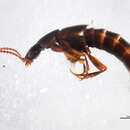Conservation Status
provided by University of Alberta Museums
Common.
- license
- cc-by-nc
- copyright
- University of Alberta Museums
Cyclicity
provided by University of Alberta Museums
Immatures collected as early as May but predominantly between August and September (Smetana, 1971). Adult specimens in the Strickland Museum collected July to August.
- license
- cc-by-nc
- copyright
- University of Alberta Museums
Distribution
provided by University of Alberta Museums
A western species ranging from Oregon to southern Alaska, and east to Montana and western Alberta (Smetana, 1971). Within Alberta the species has been collected as far north as Peace River, and within the montane parks of Banff and Waterton.
- license
- cc-by-nc
- copyright
- University of Alberta Museums
General Description
provided by University of Alberta Museums
Species is nearly black to black with the abdominal apex and pronotum of paler coloration; elytra reddish black in coloration (Smetana, 1971). The head only moderately narrows dorsally behind the eyes which are flat and only slightly prominent; temples about as long as eyes (Smetana, 1971). The posterior frontal punctures are located in closer proximity to the posterior margin of the eye than that of the head (Smetana, 1971). The microsculpture of the head is dense and made up of irregular transverse lines displaying multiple short connections which form into a mesh at the front of the head (Smetana, 1971). The pronotum is broadly rounded near the base and narrows in a curve like fashion in the front. There is little to no microsculpture on the elytra surface between punctures. In males, the aedoeagus is small and narrowed, with the paramere being dilated at the front and narrowed at the apex (Smetana, 1971).
- license
- cc-by-nc
- copyright
- University of Alberta Museums
Habitat
provided by University of Alberta Museums
Found predominantly in montane forest regions within ground litter, decaying logs, and old mushrooms (Smetana, 1971).
- license
- cc-by-nc
- copyright
- University of Alberta Museums
Life Cycle
provided by University of Alberta Museums
Evening flight has been observed in this species (Smetana, 1971). This species, like others in this genus, is documented as a strong indicator of old-growth forest (Pohl et al., in press).
- license
- cc-by-nc
- copyright
- University of Alberta Museums
Trophic Strategy
provided by University of Alberta Museums
Has been collected in old mushrooms (Smetana, 1971).
- license
- cc-by-nc
- copyright
- University of Alberta Museums

